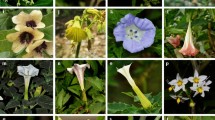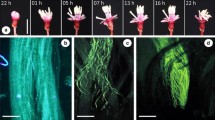Abstract
Observations on the floral biology of seven species of New World Lecythidaceae, including the first report of bat pollination for neotropical members of the family, are presented. The shift from actinomorphic flowers with many stamens to zygomorphic flowers with fewer stamens and the concomitant change from pollen to nectar as the pollinator reward are discussed and related to the respective pollinators. Several mechanisms which operate to reduce competition for pollinators between sympatric species of the family are suggested.
Similar content being viewed by others
Literature Cited
Baker, H. G. & P. D. Hurd, Jr. 1968. Intrafloral Ecology. Annual Rev. Ent. 13: 385–414.
Bawa, K. S. 1974. Breeding systems of tree species of a lowland tropical community. Evolution 28: 85–92.
— 1977. The reproductive biology ofCupania guatemalensis Radlk. (Sapindaceae). Evolution 31: 52–63.
Burger, W. C. 1974. Ecological differentiation in some congeneric species of Costa Rican flowering plants. Ann. Missouri Bot. Gard. 61: 297–306.
Cruden, R. W. 1972. Pollination biology ofNemophila menziesii (Hydrophyllaceae) with comments on the evolution of oligolectic bees. Evolution 26: 373–389.
Davis, T. A. W. & P. W. Richards. 1934. The vegetation of Moraballi Creek, British Guiana: an ecological study of a limited area of tropical rain forest. Part II. J. Ecol. 22: 106–155.
Dias, D. P. de S. 1967. PolinizaÇÃo da Castanheira do Pará por agentes naturais. Contr. do IPEAN a 1‡ Conf. Nac. da Castanha do Pará. Belém.
Dodson, C. H., R. L. Dressler, H. G. Hills, R. M. Adams & N. H. Williams. 1969. Biologically active compounds in orchid fragrances. Science 164: 1243–1249.
Ducke, A. 1948. árvores AmazÔnicas e sua propagaÇÃo. Bol. Mus. Paraense Hist. Nat. 10: 81–92.
Eyma, P. J. 1932. The Polygonaceae, Guttiferae, and Lecythidaceae of Suriname. J. H. de Bussy, Amsterdam.
Frankie, G. W. 1975. Tropical forest phenology and pollinator plant coevolution. Pages 192–209 in L. E. Gilbert & P. H. Raven, eds. Coevolution of plants and animals. University of Texas Press, Austin.
Free, J. B. 1966. The foraging behavior of bees and its effect on the isolation and speciation of plants. Pages 76–91 in J. G. Hawkes, ed. Reproductive biology and taxonomy of vascular plants. Pergamon Press, London.
Gentry, A. 1974. Coevolutionary patterns in Central American Bignoniaceae. Ann. Missouri Bot. Gard. 61: 728–759.
Heinrich, B. & P. H. Raven. 1972. Energetics and pollination ecology. Science 176: 597–602.
Jackson, G. C. & J. B. Salas. 1965. Insect visitors ofLecythis elliptica H.B.K. J. Agric. Univ. Puerto Rico 49: 133–140.
Janzen, D. H. 1971. Euglossine bees as long-distance pollinators of tropical plants. Science 171: 203–205.
Knuth, R. 1939. Lecythidaceae In Engler, Pflanzenreich IV. 219a: 1–146.
Koyama, T. 1965. Interrelationships between the tribes of Lagenocarpeae and Sclerieae (Cyperaceae). Bull. Torrey Bot. Club 92: 250–265.
— 1971. Systematic interrelationships among Sclerieae, Lagenocarpeae and Mapanieae (Cyperaceae). Mitt. Bot. Staatssamml. München 10: 604–617.
Levin, D. A. & W. W. Anderson. 1970. Competition for pollinators between simultaneously flowering species. Amer. Naturalist 104: 455–467.
Macbride, J. F. 1941. Lecythidaceae.In: J. F. Macbride, Flora of Peru. Publ. Field Mus. Nat. Hist., Bot. Ser. 13(4): 229–249.
Miers, J. 1874. On the Lecythidaceae. Trans. Linn. Soc. London 30: 157–318.
Mirbel, C. F. B. 1815. Eléments de Physiologie végétale et de botanique. Paris.
Monteiro-Scanavacca, W. R. 1975. VascularizaÇÃo e natureza de estruturas do androceu em Lecythidaceae. Bol. Bot., Univ. SÃo Paulo 3: 61–75.
Mori, S. A. 1968. The genusLecythis in Central America. M.S. thesis, University of Wisconsin, Madison.
— 1974. Taxonomic and anatomic studies inGustavia (Lecythidaceae). Ph.D. thesis. University of Wisconsin, Madison.
— 1976. New species ofGustavia (Lecythidaceae) from Panama, Colombia, and Venezuela. Brittonia 28: 289–297.
— & J. A. Kallunki. 1976. Phenology and floral biology ofGustavia superba (Lecythidaceae) in central Panama. Biotropica 8: 184–192.
Pires, J. M. & G. T. Prance. 1977. The Amazon forest: a natural heritage to be preserved. Pages 158–194 in Prance, G. T. & T. S. Elias, eds. Extinction is Forever. The New York Botanical Garden. Bronx, New York.
Pittier, H. 1912. The Lecythidaceae of Costa Rica. Contr. U.S. Natl. Herb. 12: 95–101.
—. 1927. The Lecythidaceae of Central America. Contr. U.S. Natl. Herb. 26: 1–14.
Prance, G. T. 1976a. The pollination and androphore structure of some Amazonian Lecythidaceae. Biotropica 8: 235–241.
— &S. A. Mori. 1977. What isLecythis? Taxon 26: 209–222.
—, W. A. Rodrigues, & M. F.da Silva. 1976b. Inventário florestal de um hectare de mata de terra firme km 30 da Estrada Manaus-Itacoatiara. Acta Amazonica 6: 9–35.
Schulz, J. P. 1960. Ecological studies on rain forest in northern Surinam. Meded. Bot. Mus. Herb. Rijks Univ. Utrecht, no. 163.
Spruce, R. 1908. Notes of a botanist on the Amazon and Andes. A. R. Wallace, ed. (2 vols.), Macmillan, London.
Thompson, J. M. 1921. I. Studies in floral morphology. II. The staminal zygomorphy ofCouroupita guianensis Aubl. Trans. Roy Soc. Edinburgh 53: 1–15.
Woodson, R. E. 1958. Lecythidaceae.In: R. E. Woodson & R. W. Schery (editors), Flora of Panama. Ann. Missouri Bot. Gard. 45: 115–136.
Author information
Authors and Affiliations
Rights and permissions
About this article
Cite this article
Mori, S.A., Prance, G.T. & Bolten, A.B. Additional notes on the floral biology of neotropical Lecythidaceae. Brittonia 30, 113–130 (1978). https://doi.org/10.2307/2806638
Issue Date:
DOI: https://doi.org/10.2307/2806638




